Subtotal: $
Checkout-

Three Pillars of Education
-

The Joy of Mending Jeans
-

Zero Episcopalians
-

Making Art to Mend Culture
-

Repairing Relationships
-

Forgiving the Unforgivable?
-

Not Everything Can Be Fixed
-

A Life That Answers War
-

Forgiving Dr. Mengele
-

Editors’ Picks: Faith, Hope and Carnage
-

Letters from Readers
-

Editors’ Picks: Klara and the Sun
-

My Liberal Arts Education in Prison
-

One Parish One Prisoner
-

What’s a Repair Café?
-

Analog Hero
-

The Sacred Sounds of Hildegard of Bingen
-

The Path from Death to Life
-

In Praise of Repair Culture
-

Just Your Handyman
-

To Mend a Farm
-

The Home You Carry with You

Portraits of Survival
In Tears of Gold, a new art book from Plough, Hannah Rose Thomas gives voice to women who have survived violence in forgotten corners of the world.
By Hannah Rose Thomas
February 6, 2024
Available languages: Deutsch
Next Article:
Explore Other Articles:
Simone Weil writes, “The capacity to give one’s attention to a sufferer is a very rare and difficult thing; it is almost a miracle; it is a miracle,” for this is what restores the sufferer’s humanity.footnote The attention Weil is speaking of is far from pity. It is a way of looking at and listening to another, a way of giving that person recognition. It requires an openness or receptivity, a willingness to encounter the reality of another’s suffering.
The book Tears of Gold gathers my portraits of Yazidi women who escaped ISIS slavery, Rohingya women who fled violence in Myanmar, and Nigerian women who survived Boko Haram captivity, as well as Afghan, Ukrainian, Palestinian, and Uyghur women.
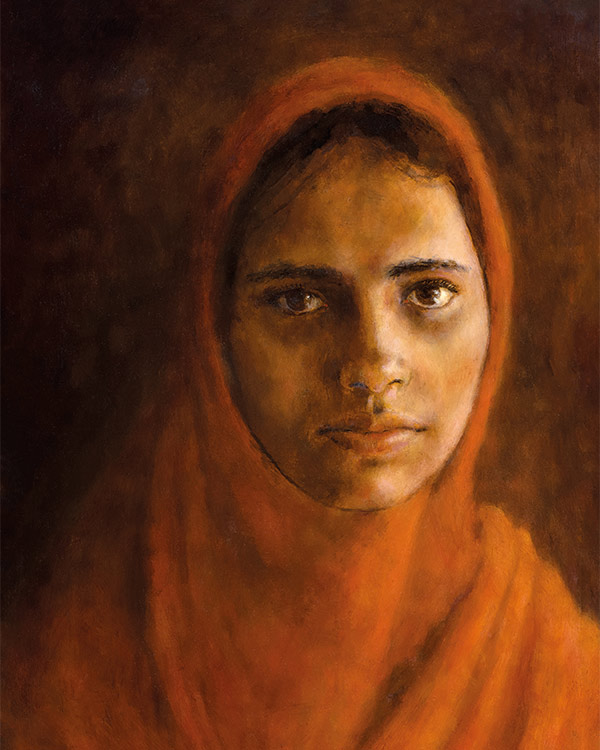
Samkina, fifteen, a Rohingya Muslim, fled to Bangladesh from Myanmar. All artwork by Hannah Rose Thomas. Used by permission.
In Iraq and Nigeria I taught the women to paint their self-portraits. I hoped this could help create a safe place for them to share their stories, process traumatic memories, and begin to heal and reclaim their voice and dignity. As women from religious minorities, they had suffered persecution and forced displacement, and many had been subjected to sexual violence. Due to the stigma surrounding such violence, they faced shame and isolation within their communities.
During the project in Nigeria, I shared my own journey through trauma for the first time. Their tender responses, even though my pain was by no means comparable with theirs, was profoundly healing. Compassion is often born from experience, for our experiences of pain can help us understand, albeit only in part, the pain of another. The women later reflected that my vulnerability helped them to feel understood. They realized they were not to blame and need not be ashamed. The conspiracy of silence that so often prevails within communities of collective trauma was broken.
The philosopher Emmanuel Levinas speaks of encountering the face of another person as an encounter with the “Infinite.”footnote Can a portrait painting help us to behold the Infinite in the face of the other? When I truly encounter another person, in that meeting of eyes I will see the humanity of this person. What does this require of me? And what do we refuse to see? How much truth can we bear to face?
Mother Teresa invites us to seek “the face of God in everything, everyone, everywhere, all the time…especially in the distressing disguise of the poor.”footnote How different our world would be if we treated each individual as a reflection of the image of God and of equal value in God’s eyes.
The use of gold leaf in my portraits is symbolic of this sacredness regardless of what someone has suffered. The technique is intentionally reminiscent of icon paintings. Mother Maria Skobtsova – a refugee from the USSR who died in the Ravensbrück concentration camp in 1945, having helped to shelter many Jews in Paris – spoke of the need to recognize people as “living icons.”footnote
These women are survivors, yet their lives cannot be reduced to a single violent experience. My paintings are an attempt to honor these “living icons” and to convey their extraordinary resilience, resistance, and dignity.
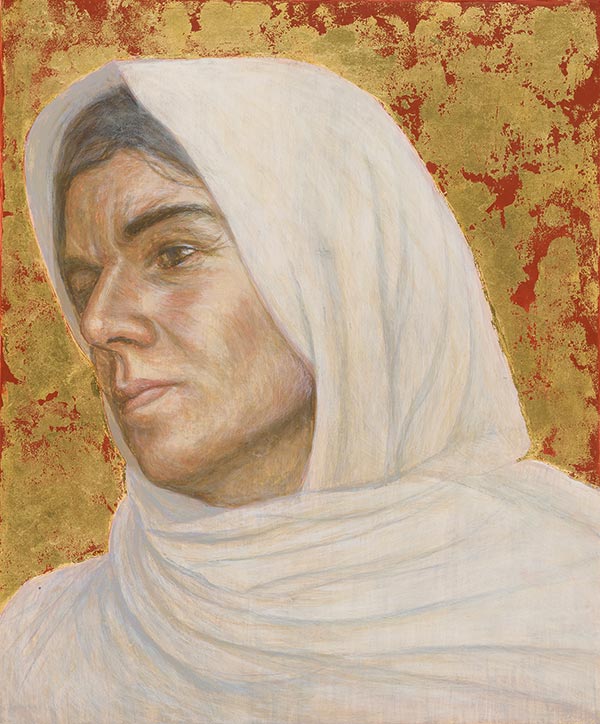
Leila (31)
They took my nine- and eleven-year-old sons.
They took my ten-year-old daughter.
They took my husband. I don’t know if my
family is dead or alive. I pray to God that
before I die I will see and hold them again.
Leila describes the moment of separation from her children and husband as death itself. She sometimes re-experiences that moment of profound pain and helplessness in nightmares that wake her, screaming.
Leila was imprisoned for two years underground in Raqqa, Syria. There she gave birth to her daughter Ghariba. In the Kurdish language, the name means “strange,” chosen to reflect that she was born into a strange world, with strange people.
On August 3, 2014, the Islamic State in Iraq and Syria (ISIS) attacked the Yazidi community in Sinjar, Iraq. Thousands of Yazidis were killed or abducted, and tens of thousands were forced to flee. A UN human rights commission found that “within days of the attack, reports emerged of ISIS committing almost unimaginable atrocities against the Yazidi community: of men being killed or forced to convert; of women and girls, some as young as nine, sold at market and held in sexual slavery by ISIS fighters; and of boys ripped from their families and forced into ISIS training camps.”footnote (The Yazidi adhere to an ancient religion distinct from Christianity and Islam; ISIS’s genocidal campaign targeted Christians and other religious minorities as well.) According to a 2022 UN Security Council report, nearly a decade later, 200,000 Yazidis continued to live displaced in camps only hours away from their homeland, 2,800 Yazidi women and children remained in captivity, and Yazidi women were still being sold online.footnote
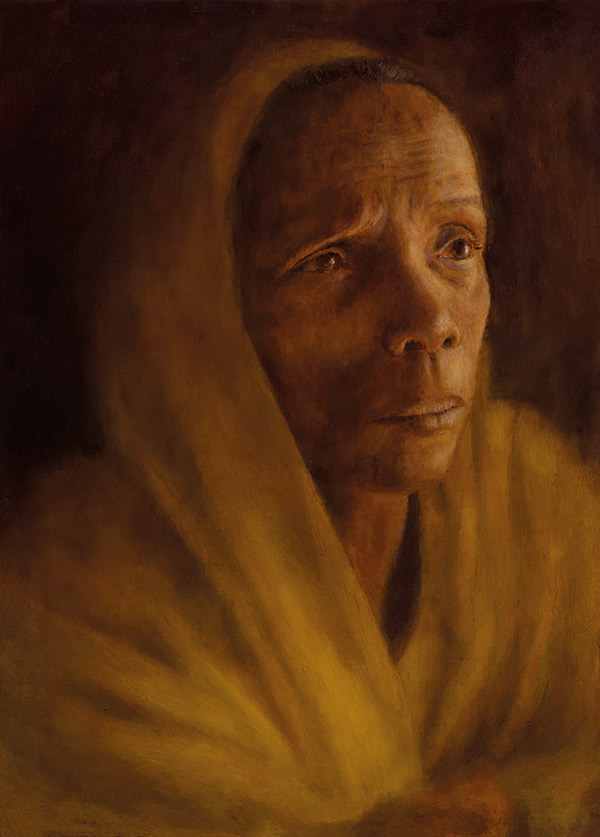
Lalu (45)
I look much older than my age
because of the sorrow and suffering
I have seen.
The Myanmar military captured Lalu’s family, forcing them into a house to be burned. While the army was rounding up more people in the village, the family escaped. However, one of her nephews was killed when his clothes caught on fire, and one of her grandchildren was shot by the military as they fled.
The remaining family arrived at the Bangladesh border and crossed the river by boat. The military pursued them and the boat sank, killing another of Lalu’s grandchildren. Lalu’s husband was saved from drowning but became dangerously unwell – he died soon after they arrived at the refugee camp.
Lalu feels unspeakable grief for the loss of her loved ones and has been unable to move on, her mental and physical health increasingly frail.
In August 2017 more than 650,000 Rohingya Muslims fled violence and persecution in Rakhine State in Myanmar. At the peak of the attacks, in one day alone a hundred thousand Rohingya crossed the river into Bangladesh.footnote An estimated one million Rohingya found provisional shelter near the southeastern Bangladeshi coastal city of Cox’s Bazar. This settlement, Kutupalong, remains the largest refugee camp in the world.footnote The United Nations has described the violent military crackdown as a “textbook example of ethnic cleansing.”footnote Most of the people who escaped were severely traumatized after witnessing unspeakable atrocities: entire villages razed to the ground, families separated and killed, women and girls brutally gang-raped.
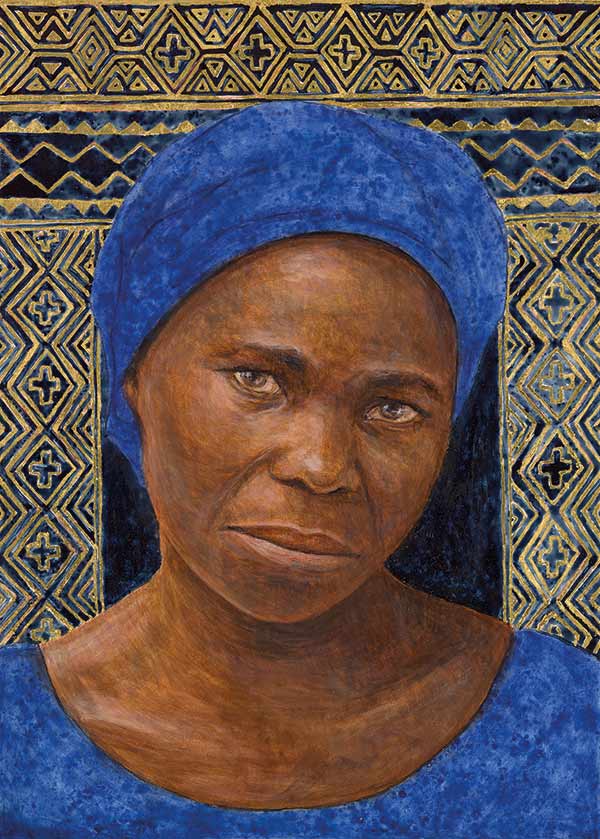
Charity
I can recount three different times
that I was beaten by my husband
because I came back with a child.
Charity was kidnapped by Boko Haram when she was out walking with her husband. Her husband managed to escape, but Charity failed to get away. She was held captive by Boko Haram for three years and was forced to “marry” a militant and convert to Islam. Charity was raped and subsequently gave birth to a baby girl named Rahila.
The Nigerian military rescued Charity; she was reunited with her husband in a camp for internally displaced people. Her pain was magnified when her husband beat her and rejected her baby. In the camp she faces abuse, rejection, and isolation. Access to food and water is a daily struggle.
Since the beginning of the Boko Haram insurgency in northeast Nigeria in 2009, millions have been forced from their homes. Boko Haram abducted thousands of women, holding them captive and subjecting them to sexual violence and forced marriage. After the kidnapping of 276 schoolgirls in Chibok in April 2014, the hashtag #bringbackourgirls went viral, retweeted by celebrities and public figures from Kim Kardashian to Michelle Obama. Since then, the security situation in northern Nigeria has been further exacerbated by escalating conflict between predominantly Muslim and nomadic Fulani herdsmen and Christian farmers. Fulani militants have used sexual violence to target women as a way to devastate communities.
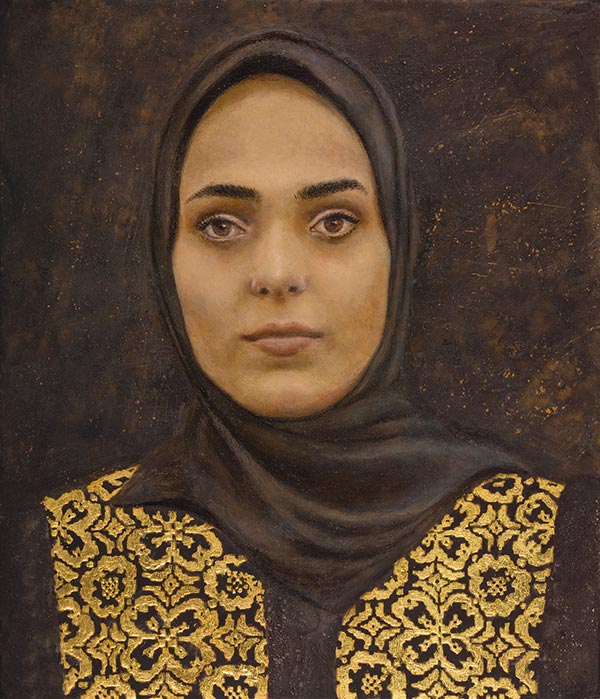
Zainab (22)
The passing of days and the sun rising each
morning troubles me. I am still hoping to
open my eyes, as I used to, to my mother’s
smile and affection. I am still longing for one
hug from Hana. I used to stay up late with
Ahmed, who would ease away the worries
and pain of life with his infectious laugh.
His laughter still echoes in my ears, so much so
that I sometimes turn around to see if he is
really there. Wherever I look, I cannot help
but remember one of them.
On May 16, 2021, Zainab al-Qolaq lost twenty-two members of her family – including her mother, Amal, her only sister, Hana, and two brothers – when an Israeli air strike hit her home in Gaza. Zainab was trapped under the rubble for twelve hours.
In the year following the airstrike, Zainab devoted herself to processing her grief through her art. Her exhibition in Gaza was entitled: “I’m 22, I lost 22 people.” Her powerful paintings depict her pain and trauma, which cannot be communicated in words. Zainab says that she used the universal language of art to convey her voice and feelings, for others to understand the grief she carries each and every day. She writes, “They may have removed the rubble above me, but who will remove the scattered rubble from my heart?”
Unable to travel to Gaza in person, I met with Zainab over Zoom in 2022. Her story stands in for the many civilian victims on both sides of the conflict between Hamas and Israel.
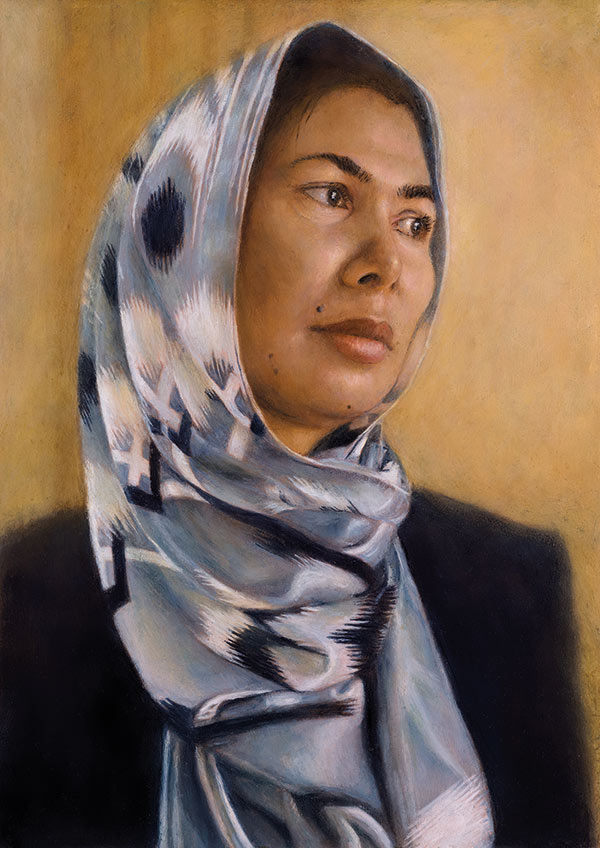
Tursunay (44)
Their goal is to completely destroy us – physically
and psychologically. They want to take away our dignity,
our humanity, and our ability to feel joy. I will bear the
scars of what they did to me for the rest of my life.
Tursunay Ziyawudun spent nine months imprisoned in an internment camp in the Uyghur region of northwest China (formally known as Xinjiang Uyghur Autonomous Region). She describes multiple episodes of torture, public humiliation, and brutal sexual violence including gang rape at the hands of camp guards. She remembers how the women she was imprisoned with were traumatized by their experiences, some screaming, some sobbing, and others silently rocking back and forth after returning from the “black rooms” where the assaults were carried out.
Tursunay was able to flee to the Unites States. From there she speaks out for the women she knows are still suffering in her homeland. In her portrait she wears a beautiful traditional Atlas silk scarf.
Since the Communist Revolution in 1949, the Chinese government has increasingly stripped away the freedom of Uyghur Muslims, systematically suppressing their language, religion, and culture, and destroying mosques and other religious sites. Since 2018 there have been reports of an oppressive system of high-tech mass surveillance, slave labor, mass incarceration, forced organ-harvesting, and Uyghur women being sterilized or forced to terminate pregnancies.footnote
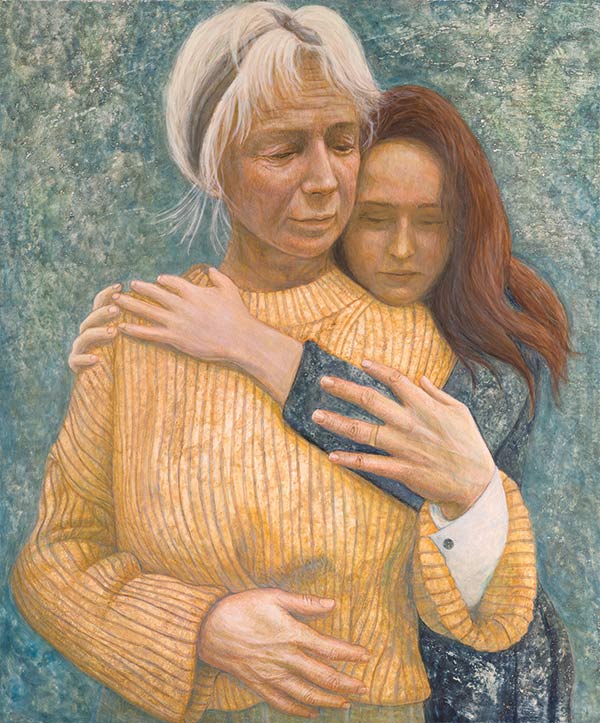
Maria and Nadiia
The war is endless and thousands of people
there are waiting to be heard in prayer.
My mother and I were among them.
It is a traumatic experience to have
to leave home without a plan.
Maria and her mother Nadiia were living in Kyiv when the war began on February 24, 2022. Maria awoke to her mother screaming: “Masha, wake up! The war has started.” Initially they were in denial, but after twelve sleepless days and nights hiding in their basement as a bomb shelter, they decided to leave the country and seek refuge in the United Kingdom.
Since the onset of the Russian invasion, one-third of Ukrainians have been forced from their homes. This is the largest movement of refugees in Europe since World War II,footnote with nearly eight million refugees from Ukraine spread across Europe.footnote There has been an outpouring of support, which has led many to hope that this could set a precedent for treating all refugees more humanely. If nothing else, it has exposed the politicized, and often discriminatory, nature of refugee protection. Refugees arriving in Europe from the Middle East, Asia, and Africa are far more likely to face border violence, detention, and drawn-out asylum procedures.footnote Who are we to determine which refugees are worthy of compassion? As Maria herself expresses it: “It does not matter what nationality you are; what matters is what you are doing in this present moment. For humanity has no geography, and kindness has no nationality.”
Footnotes
- Simone Weil, Waiting for God, trans. Emma Craufurd (New York: Harper Perennial, 2009), 64.
- Emmanuel Levinas, Totality and Infinity: An Essay on Exteriority (Pittsburgh: Duquesne University Press, 2013), 199.
- Mother Teresa, In the Heart of the World: Thoughts, Stories, and Prayers (Novato, CA: New World Library, 2010), 33.
- Maria Skobtsova, Mother Maria Skobtsova: Essential Writings (Maryknoll, NY: Orbis Books, 2003), 81.
- The International Independent Commission of Inquiry on the Syria Arab Republic, “They Came to Destroy”: ISIS Crimes against the Yazidis, June 15, 2016.
- United Nations Security Council, Women and Peace and Security: Report of the Secretary-General (October 5, 2022), III.C.40.
- Tengku Shahpur and Abellia Anggi Wardani, “Relocation, Climate Change and Finding a Place of Belonging for Rohingya Refugees,” Journal of Peacebuilding & Development 17, no. 3 (December 2022): 274–88.
- United Nations Office for the Coordination of Humanitarian Affairs, “Rohingya Refugee Crisis,” unocha.org/rohingya-refugee-crisis, accessed February 27, 2023.
- United Nations Security Council, Report of the Independent International Fact-Finding Mission on Myanmar (September 12, 2018).
- Baroness Helena Kennedy, foreword in Ewelina U. Ochab and David Alton, State Responses to Crimes of Genocide (London: Palgrave Macmillan, 2022), ix–x.
- United Nations Security Council, Women and Peace and Security, III.C.36.
- UNHCR Data Portal, “Ukraine Refugee Situation,” accessed January 16, 2023.
- Emily Venturi and Anna Iasmi Vallianatou, “Ukraine Exposes Europe’s Double Standards for Refugees,” Chatham House, March 30, 2022.
Already a subscriber? Sign in
Try 3 months of unlimited access. Start your FREE TRIAL today. Cancel anytime.

































Francis Pray
Hannah Rose Thomas is a beautiful woman with a beautiful soul. Her paintings helped me see past the dry, detached statistics of war and sense some of the deep pain of these women. I admire her courage to look deeply into the hearts of the victims when most would rather look away.
Michael Nacrelli
A poignant and moving piece, except for the pontificating at the end. Does Thomas really believe there should be no criteria for evaluating asylum claims?